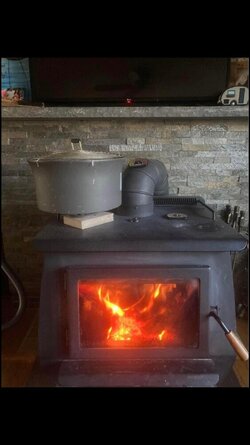Thanks, good advice. I have not been doing full open burns on reloads. The stove has been heating and burning so nice that I have been adding wood, letting it catch and burn for only a few minutes so that it gets going well and then turning the thermostat back a bit to keep the temps comfortable. Will let my burns go a bit longer so that when I reload I can let the stove run longer full open without it cooking us out.
Sorry for the delay. I am not sure how much overtime I have been working in the last 16 days or so, but it has been an unreasonable amount.
Do we see creo-sicles around Fairbanks, yes. Do I see creo-sicles on my stack, only very rarely. Our local BK dealer is excellent. If they installed your chimney and aren't worried, you are golden.
The main thing I see now that I have caught up from having been tagged, is the bake portion, bake down, bake out portion of the burn.
When I am down to hot coals, a glob maybe basketball sized +/- it is time to reload. Then get all the coals lined up somewhere, manual says to the front, then load the firebox to the gills, to the rafters, cram every stick in there you can.
With the loading door opened and the bypass door open, let the coals catch the new fuel on fire. Once the new fuel has caught good, leave the loading door just cracked with the bypass door still open and let the new fuel get to a good ripping burn. When it is first getting going you will hear kind of huff-pause-huff-pause. Once it is drawing good and the fuel is well caught you should hear just a steady rush or roar.
Close the loading door. WIth the bypass door still open we now wait for the combustor temp to come up to the active zone. On a hot reload, my definition, the combustor hasn't dropped out of the active zone. With the new fuel well engulfed, the loading door closed, the combustor up to active zone, now we close the bypass door and enter the bake down zone.
Or bake out, or just the "bake" What you got is a box full of desirable new fuel under 20% MC, but closed up inside a steel box at 600 degrees F. The last of that water is getting baked out now. Takes about half an hour. Leave the thermostat, the throttle at full, top of the swoosh, let it thunder while that free water gets baked out.
Then, after the 30 minutes, with your new fuel baked down to 0.000% moisture content in a 600 degree oven, now turn the throttle/thermostat down to your desired cruise setting. No more creosicles.


